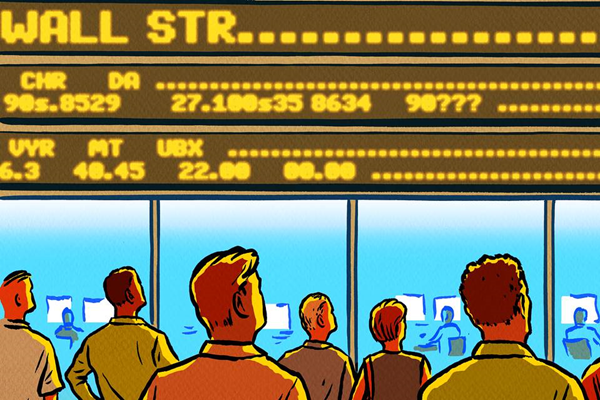THE
WALL STREET JOURNAL.
Markets |
Your Money | Weekend
Investor
Upon Further Review, Don’t Sweat the Small Stuff
After hearing from
some investors and researchers, Jason Zweig isn’t so sure about
his take in last week’s column
|

Photo: Christophe Vorlet |
By
Jason Zweig
June 30, 2017 3:32 p.m. ET
How
much should you care about the decline in the number of publicly traded
companies?
The
number of stocks has halved over the past two decades, to fewer than 3,600 from
nearly 7,400, with most of the declines coming among the smallest companies.
That, I
argued in a column last weekend, may be making it tougher for stock pickers to
beat the market and for investors to forecast future returns from past data.
Now, I’m not so sure. In the past few days I’ve heard from several leading
investors and researchers who feel I got parts of that story wrong. There’s a
lot that I, and you, can learn from their criticisms, mainly about the role that
small companies play in the markets.
Ronen
Israel, a partner at AQR Capital Management LLC, a firm in Greenwich, Conn.,
that manages more than $180 billion in assets, doesn’t think the decline in the
number of small companies is a big deal.
“That
part of the universe is so small,” says Mr. Israel, “that it doesn’t really
affect most portfolio managers because they can’t invest there anyway.”
The
1,900 most minuscule companies combined are only 2% of the total value of the
U.S. stock market, according to the Center for Research in Security Prices at
the University of Chicago’s Booth School of Business.
Many
such minnows have market values barely above $15 million, making them
untouchable for the typical fund manager and unlikely to be a major factor in
the performance of stock pickers, says Mr. Israel.
Or
consider “factor investing,” which selects groups of stocks based on how big
companies are, how much their shares fluctuate, how expensive they are relative
to asset value and so on. Much of that underlying research is based on periods
when twice as many stocks existed as today. Is it still valid?
So many
of the stocks that disappeared were so small that they shouldn’t overly
influence the results, says Mr. Israel, except in strategies that weight stocks
equally rather than by size as most indexes do.
Larry
Swedroe, director of research at Buckingham Asset Management LLC in St. Louis,
points out that the performance of small stocks has been relatively consistent
all the way back to 1926, regardless of how many there were.
Jay
Ritter, a finance professor at the University of Florida who is a leading
authority on initial public offerings, says the shrinkage of small stocks isn’t
new. While it was common for more small companies (with under $50 million in
sales) than big ones to sell shares to the public in the 1980s and 1990s, that
hasn’t happened in a single year since 2000.
The new
chairman of the Securities and Exchange Commission, Jay Clayton, has said that
he hopes to encourage more small companies to list shares, at least partly by
reducing red tape.
Regulatory costs aren’t the main issue, says Prof. Ritter: “Small companies are
having a lot of difficulties competing with big companies, mainly due to
technology and globalization.”
For evidence, look no
further than the IPO of the meal-kit delivery service Blue Apron Holdings Inc.
on Thursday. It arrived on the table cold, closing unchanged at $10 on its first
day, after the company had sought to get between $15 and $17. The offering
faltered partly because of the threat of intense competition from
Amazon.com Inc.
“Getting big fast is more important than it used to be,” says Prof. Ritter. So
the venture-capital funds backing many startups protect their investments by
merging with or selling to other companies rather than taking them public.
In the
1990s, IPOs regularly accounted for more than half of all “exits,” or sales, by
venture-capital firms; from 2001 onward, they haven’t accounted for more than
20% in a single year, calculates Prof. Ritter.
The
losers here are small investors who can’t invest in venture-capital firms, says
Brian Buenneke, a partner at
Pantheon Ventures in San Francisco, which manages about $36 billion in
venture-capital and private-equity funds. “Individual investors have access to
fewer companies and slower growth. They’re really getting shut out.”
The
earliest and biggest gains are being captured by a wealthy, closed and connected
investing clique. If that continues, it could jeopardize popular support for
free-market policies.
It’s
worth pointing out that most small companies, even the most promising ones, end
up underperforming. And big investors have poured so much money into
venture-capital and private-equity funds that recent returns, on average,
haven’t been significantly different than in the public markets. But those few
who win big win very big indeed.
“Historically, great companies went public far earlier and in theory anyone
could identify their promise and be rewarded for taking that risk,” says Lauren
Loktev, a partner at Collaborative Fund, a New York-based firm that has invested
about $125 million in startups. “Now, by the time they go public, the
exponential growth isn’t there anymore.”
Write to
Jason Zweig at
intelligentinvestor@wsj.com
